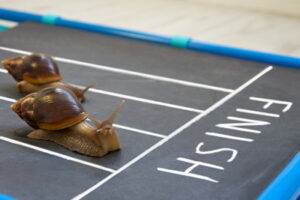 When people think about racing animals, it is common for them to bring to mind horse racing and greyhound racing. They are, after all, the most popular animals to race, and they receive many, many sports wagers on the races every year. Yet even though these are the most popular, they are not the only animals to be raced around the world. Different countries enter different animals into races, and even place bets on which competitor will win the races.
When people think about racing animals, it is common for them to bring to mind horse racing and greyhound racing. They are, after all, the most popular animals to race, and they receive many, many sports wagers on the races every year. Yet even though these are the most popular, they are not the only animals to be raced around the world. Different countries enter different animals into races, and even place bets on which competitor will win the races.
As it happens, there are many types of animal sporting events, with varying levels of participation also coming from humans. Some are solely between the animals themselves, while others make use of animals in a lesser role. However, we’re going to find out the types of animals raced around the world, and which ones are the fastest as well as the slowest. Plus, when you think of horse racing or greyhound racing, you may just be considering a standard race that sees them compete against each other. Keep in mind that sports like harness racing, dogsled racing and even chariot racing have existed or do still exist.
To make this collection of animal races a little simpler, we’re going to be running down them in order from fastest animals to the slowest. In that case, you can probably guess that snail racing won’t be taking prime position here!
Ostriches (43mph)
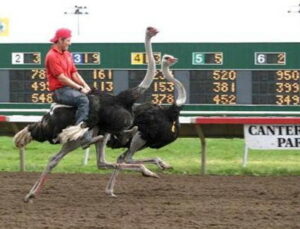
While greyhounds may be the fastest animals for racing, this is only by a very small margin. Ostriches have been used for racing purposes in South Africa and the United States of America, with a particular focus on it in Chandler, Arizona for the latter. An ostrich farm was opened up in Jacksonville, Florida in 1892 as a tourist attraction, and it ended up becoming one of the most visited locations within the state. Other than Arizona, ostrich racing also occurs in the states of Nevada, New Orleans, Minnesota, Kentucky and Iowa.
Before an ostrich race begins, jockeys will examine the birds while they are in their pens, and those jockeys will also only wear helmets as protective gear during a race. Ostriches have a wagon attached to them for a jockey to sit in, and it isn’t uncommon for some of the riders and their wagons to fall to the ground during a race.
Ostriches themselves have the capability to run up to 70 kilometres per hour (around 43 miles per hour). A single ostrich stride can cover up to 16ft in ground, and they are known as the fastest land bird.
Camels (40mph)
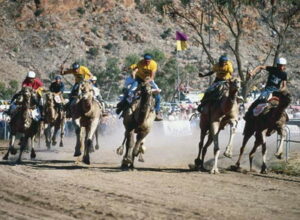
The races occurring usually tend to have child jockeys riding the camels, as they are lighter than grown adults, and therefore don’t slow the animals down as much. Child jockeys from Pakistan, Bangladesh and other countries, were officially banned in the UAE (in 2002) and Qatar (in 2006), following an outcry about human rights. Saudi Arabia, Bahrain and other locations continue to utilise them, though.
Robot jockeys were introduced instead of child jockeys, which were developed in 2004, and these are still phasing out the utilisation of children.
One highly popular camel racing event is actually held in Australia, though. This is the Camel Cup, and the event occurs at Alice Springs in the Northern Territory. The race in that tournament with the biggest prize is The Boulia Desert Sands, offering $25,000 to the winner.
Buffalo (35mph)
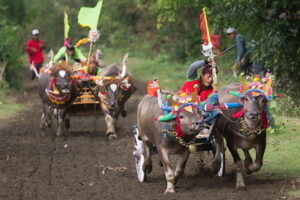
Back in the 1930s, Makepung occurred on wet fields so as to facilitate the working of the agricultural land. Today, it takes place on drier land, made up of 125 metres of wet rice field. Four pairs of buffalo compete in a single round, and it is not uncommon to see jockeys fall from their ploughs into the muddy rice field lands. It’s a long race as well, lasting for at least five hours, and the buffalo are divided into three racing categories.
Seven circuits, spread out in different locations of the Jembrana Regency in west Bali are run, with one of the main ones being the Sangyang Cerik circuit in the village of Tuwed. Prior to the day of the finals, teams will gather together to take part in evening parties, featuring artistic performances and other amusing acts. Visitors from all over the globe get to spectate at the race, enjoying the buffalo fashion show where the animals are dressed up in different jewels and ornaments. There is even an award for the best dressed buffalo!
Cows (25mph)
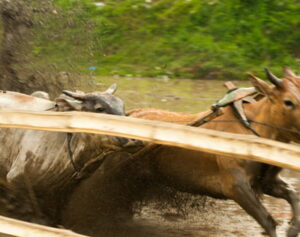 When people think of racing farm animals, it is usually horses that spring to mind. However, cow racing is also something that takes place in the world, too. Cattle can actually run at great speeds of up to 40 kilometres per hour, and this is something that people in Australia clearly took advantage of, featuring cow racing at the Compass Cup event every year. That event ran for 46 years, and it only came to an end in 2019, hosted by volunteers and local community groups. The demise of the Compass Cup competition was not due to lack of support from the Council of the area, but due to the fact that there was a “mood for change”.
When people think of racing farm animals, it is usually horses that spring to mind. However, cow racing is also something that takes place in the world, too. Cattle can actually run at great speeds of up to 40 kilometres per hour, and this is something that people in Australia clearly took advantage of, featuring cow racing at the Compass Cup event every year. That event ran for 46 years, and it only came to an end in 2019, hosted by volunteers and local community groups. The demise of the Compass Cup competition was not due to lack of support from the Council of the area, but due to the fact that there was a “mood for change”.
In total, 24 cows were used in the race, being chosen on the morning of the event. Each cow also had a rider and was accompanied by four supporting crew members, known as “urgers”, who would keep them mounted. Spectators were able to join in on the happenings, choosing to be riders or supporting crew, and the race took place over a 60-metre-long course, with three races (two heats featuring 12 cows each and then the final featuring six cows from each heat).
Cows in such races were not trained for such, thereby making it quite the eventful and often chaotic competition. Some cows wouldn’t move at all, while others simply moved in circles and on their own route. Yet around 5,000 spectators would attend the event each January.
Sheep (25mph)
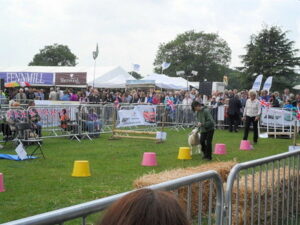
In Australia, there is an event known as the Booligal Sheep Races, which occurs every year in October at the Booligal Cricket Ground, New South Wales. These have been running for more than 20 years, featuring heats of 5 sheep all trying to acquire the Booligal Cup. Visitors to the event even have the opportunity to hire a sheep on the day to compete in a race.
Rabbits (25mph)
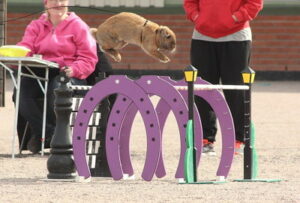
It quickly gained traction, and other countries in Europe opted to introduce their own rabbit show jumping events. Norway was one of the first to follow suit in 1990, developing its own new clubs.
Rabbits participating in such events are required to have agility, courage and determination, and breeders train their bunnies eight weeks prior to a show-jumping event taking place. This involves them walking the rabbits with a harness on and encouraging them to jump over the obstacles.
The competitions see rabbits take part in four different rounds, including various barricades, rails and jumps while on a lead. Courses are straight, crooked, long-jumps and high-jumps, and these are each divided into five difficulty levels. Any rabbit breed can compete in kaninhop, although smaller rabbits have trouble competing due to their size, while large rabbits are prone to injury upon landing after jumping high obstacles, thanks to their weight. There is a World Record jump from a rabbit of 99.5 cm, while the farthest distance jumped is 3 metres.
Hamsters (6mph)
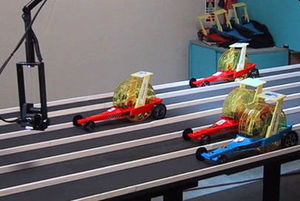
Strangely enough, betting on these races became quite popular in the UK in 2001. It was then that a foot and mouth epidemic threatened the country’s livestock and cancelled various races. This led to a decrease in the revenue for bookmakers, so professional hamster racing was introduced, and promoted by the sportsbooks. Online bookmaker Blue Square (which was purchased by Betfair in 2013) is responsible for organising the first ever hamster race. It saw a series of qualifying rounds take place throughout the week, as well as the final race. In fact, the main event was broadcast via webcast and other media outlets such as BBC London and Sky News.
Yabbies (3mph)
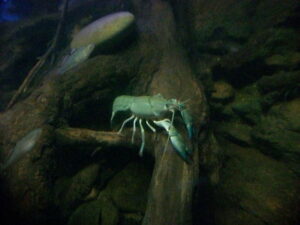
Kids may grow up catching yabbies in the country, but there are certain locations where they are raced. One location that this occurs is the town of Talbot in Victoria, with others including Moonie and Kajabbi.
Four races occur at the International Yabby Races, which are held in Windorah, Queensland. In these races, 10 yabbies are released to slowly make their way towards a green line that has been spray painted onto gravel.
The first one to cross that green line is deemed the winner.
Cockroaches (3mph)
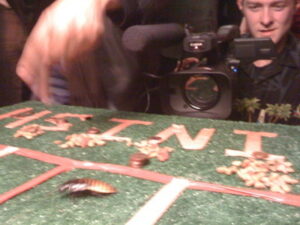
Every year on January 26 (which is Australia Day), a special event takes place featuring cockroach racing. There are 14 different races involved, including something known as the steeple chase race. And other than this Australia Day tournament, six other cockroach racing events happen across the country.
The primary reason why these events have continued on over the years is due to the gambling activity that takes place on them. Yet it has even spread to other locations, with the USA also getting involved in cockroach racing. The state of New Jersey conducts such a race to predict the democratic presidential candidate each four years!
Snails (0.03mph)

A circular track is most often used, with the snails beginning in the centre of it and racing to the perimeter. Owners and spectators cannot touch the snails during the race or get involved in any other kind of tampering. The track is made up of a damp cloth on top of a flat surface and it is around 13 to 14 inches in diameter. Snails have numbered painted onto their shells, and the first one to touch the outer circle of the ring is determined as the winner.
World Championship Snail Racing occurs in Congham, Norfolk, and this event was founded by Tom Elwes. First running in the 1960s, it has continued to take place every year since (with the exception of 2020 and 2021 due to COVID-19), and the winning snail in 2019 was known as Sammy.